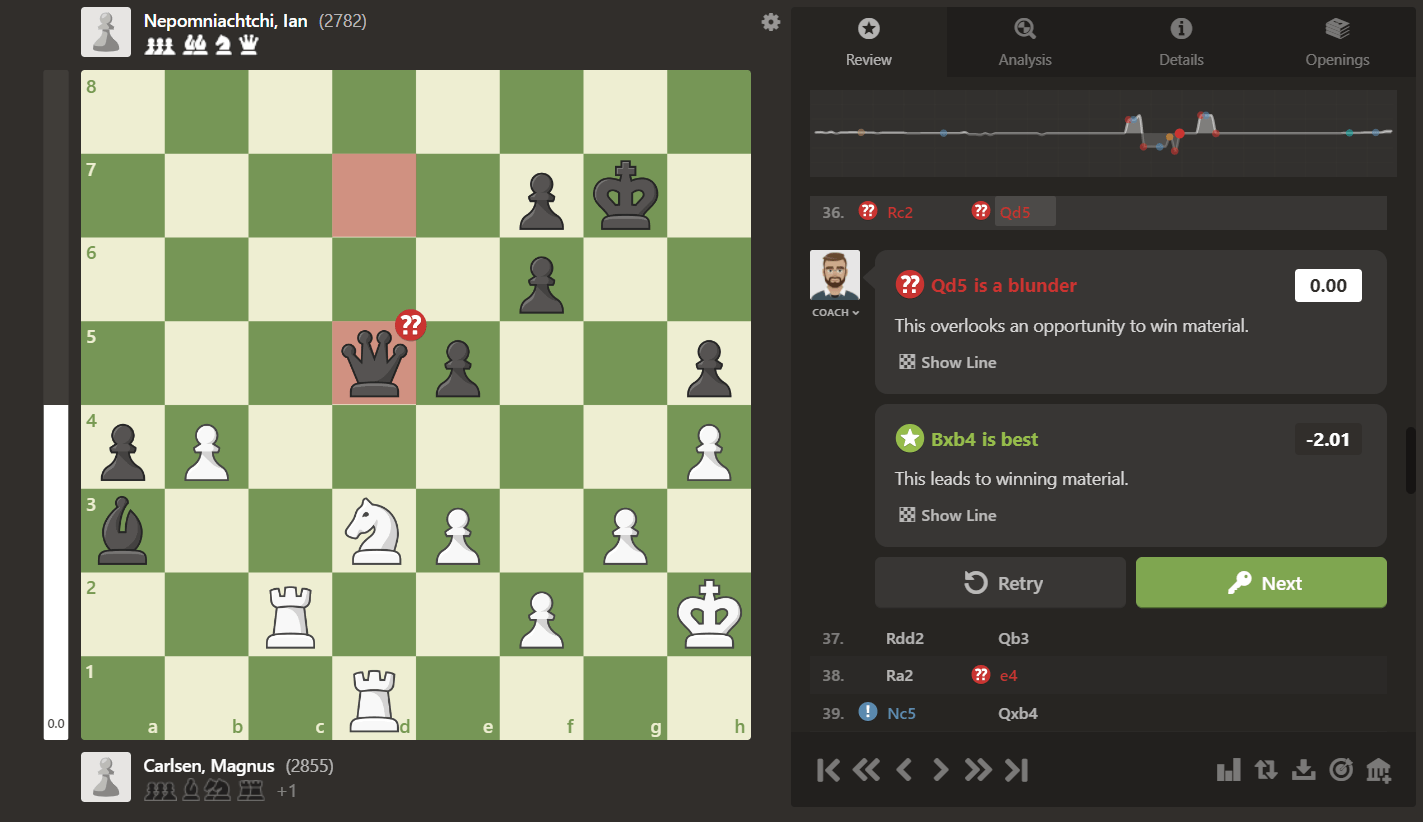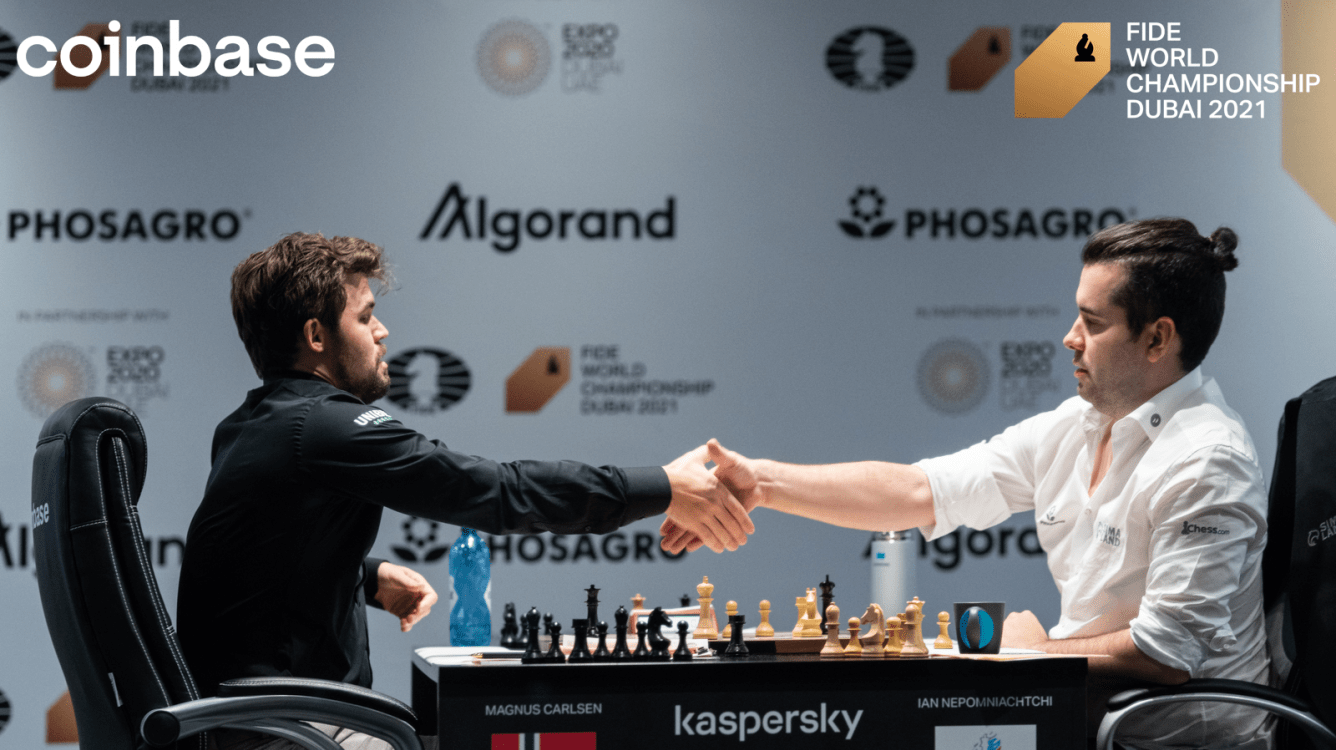
Carlsen Wins Game 6, Longest World Chess Championship Game Of All Time
GM Magnus Carlsen defeated GM Ian Nepomniachtchi in a record 136 moves in game six to score the first win of the 2021 FIDE World Chess Championship. The world champion's victory came after five draws in the championship that has a €2 million prize fund. Game seven is scheduled for Saturday at 16:30 Dubai time (13:30 CET, 4:30 a.m. Pacific).
Carlsen had to wait five years and nine days to win a classical world championship game. It took him two days to win this one.
For game six, the players spent a staggering seven hours and 47 minutes at the board and finished 17 minutes past midnight in Dubai. The game started on Friday and ended on Saturday—something that hadn't happened since adjournments were abolished in the mid-1990s.
In terms of moves, the game broke the record of the longest game in world championship history. Before today, it was the 124 moves played in the fifth match game of Korchnoi-Karpov, Baguio City 1978, but with 136 moves, we now have a new longest game.
In the previous six world championship matches that started with five draws, game six also ended in a draw, but Carlsen broke that spell today. He emerged as the winner of a historic fight with different phases and different faces.

The intrigue, once again, started at the very first move: Carlsen did not go 1.e4 as in the fourth game but returned to 1.d4 like in game two. He tried a different move order on move three though, one that had never been tested in world championship matches before.
Carlsen, who was playing his third white game and wearing a light suit (while he had been sporting a dark suit during his black games!) did similar things as in that second game: a Catalan setup followed by a prepared pawn-sacrifice with 9.Qc2 and 10.Nbd2!?—described as "a fantastically creative idea" by Caruana.
It was the kind of daring opening play that GM Danill Dubov could have invented, and, having a history of helping Carlsen, maybe he did.
Position after 10.Nbd2.
Nepomniachtchi needed some time on the clock to find his answer, spending almost seven minutes on 8…dxc4 and then 13 minutes on 10…Nc6. As those moves weren't hard to predict, the experts were somewhat surprised that Carlsen spent 12.5 minutes on his 11th move.
"I couldn't remember the lines properly there, so from there on I had to kind of invent things over the board," he said afterward. "In any case, I think after that it was fairly balanced most of the time."
What followed, however, impressed everyone. Nepomniachtchi's 11...b5 was bold, concrete, and confident, a great shot with which he made clear that he wasn't wishing to play the game on Carlsen's terms. He knew what he was doing, and he just scored another opening success.
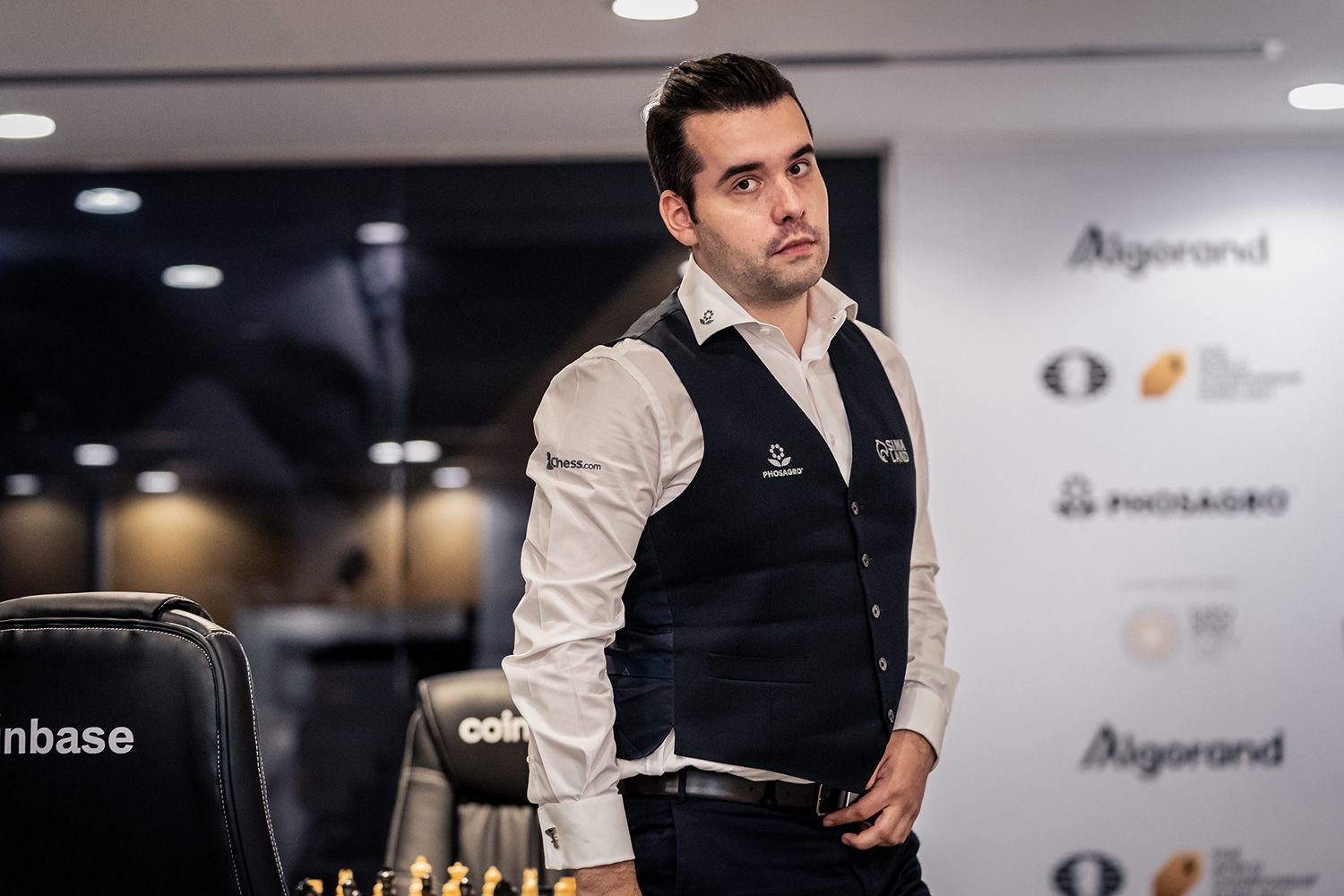
The next interesting moment came on move 17, where the challenger chose to play the position with the queens on the board. Since the endgame looked quite safe for him, it was another clear sight of confidence together with the move 18...Nd4, which was "in between ambition and safety" (Caruana).
Nepomniachtchi liked his bishop pair, and commented: "Basically, I thought that I should play for more than a draw after the opening."
Basically, I thought that I should play for more than a draw after the opening.
—Ian Nepomniachtchi
On move 25, with 22 vs 32 minutes on the clock, Carlsen was the one under slight pressure as he had to make the choice of whether to trade the queen for two rooks, or not. He did.
The position where Carlsen traded his queen for two rooks on c8.
"Fairly dramatic stuff," said GM Vishy Anand from the commentary booth in Dubai, but the real drama was still to unfold.
Carlsen, about 25...Rac8, which offered that trade: "I felt like we were both risking a bit, but I thought Black was maybe risking a bit more. It meant that we would get a serious struggle, which I was happy with."

Three earlier games in world championship history saw this material imbalance of queen vs. two rooks, the most recent involving Anand himself, who drew the ninth game vs. GM Veselin Topalov in their 2010 match. There was also a Q-RR draw in Spassky-Petrosian in 1966, while GM Vladimir Kramnik won with the rooks vs. GM Peter Leko in the first game of their 2004 match.
With 10 moves to go until the first time control, Carlsen still had less time on the clock: three minutes until move 40 against 23 minutes for Nepomniachtchi. Note that the players are only getting the 30-second increment after move 60, which they hadn't reached yet in this match.
Seriously, why did they invent increment? I suppose they wanted to kill randomness, and now we want to kill accuracy...
— Jonathan Tisdall (@GMjtis) December 3, 2021
Despite thinking for nine minutes on his move, Nepo was the first to err with 31...Bb2. Carlsen initially reacted well with 32.Rc5! when 32...Qd6 led to the diagram position.
Position after 32...Qd6.
Nepomniachtchi's chair was shaking visibly as he tapped his foot while spinning a pawn with his right hand. While photographers were aiming their cameras like snipers, both players looked extremely focused in what was clearly the tensest moment of the match so far.
With exclusive footage from the playing hall on Twitch, the Chess.com English-language broadcast peaked at almost 90K concurrent viewers around this time (not counting the 32K on YouTube and our broadcast in nine other languages). But that was only the beginning...
We're the #1 stream on Twitch right now! #CarlsenNepo pic.twitter.com/Cjsxxd0420
— Chess.com (@chesscom) December 3, 2021
All those viewers saw the evaluation bar for Carlsen suddenly dropping fast when he played 33.Rd1?—meanwhile, 33.Rcc2! Bxa3 34.Nf4 was given as winning by the engines.
Caruana: "I've never been so disappointed."
Carlsen, after the game: "That was not on my radar."
White's a-pawn was traded for Black's b-pawn, and a move later Nepomniachtchi, with three minutes and 40 seconds on the clock, could have safely taken White's b-pawn as well, but didn't.
Caruana: "I'm puzzled."

Instead, Nepomniachtchi pushed his e-pawn one square, and pushing it all the way to e4 was the mistake that gave Carlsen another big chance. However, with precisely half a minute left for his 40th move, the world champion missed that one as well.
Position after 39.Qxb4.
Grabbing the pawn on e4, as played by Carlsen, was tempting and not bad, especially with limited time. However, as Caruana quickly suggested in the Chess.com live broadcast, 40.Rdc2! would have stalemated both the black queen and bishop. Black can only make pawn or king moves, and won't survive it.
"Ian Nepomniachtchi has one more move to make or he loses on time!" 🤯🤯🤯 #CarlsenNepo
— ChesscomLive (@ChesscomLive) December 3, 2021
—@DanielRensch pic.twitter.com/w4oc2cUaVq
Nepomniachtchi ended up making his 40th move with just five seconds left on the clock. As both players reached the time control, surviving the first serious time-trouble phase in the match, the position on the board was objectively even again, but still not without life.
And now it's boring again. Why do they get more time after 40 moves?
— Anish Giri (@anishgiri) December 3, 2021
As the players continued in the fifth hour of play, Nepomniachtchi impressed the experts by doing something he is known for: playing fast in complicated positions. It seemed like he intended to put Carlsen under pressure on the clock once again and, according to Caruana, it was indeed the clock that the world champion had to fear the most.
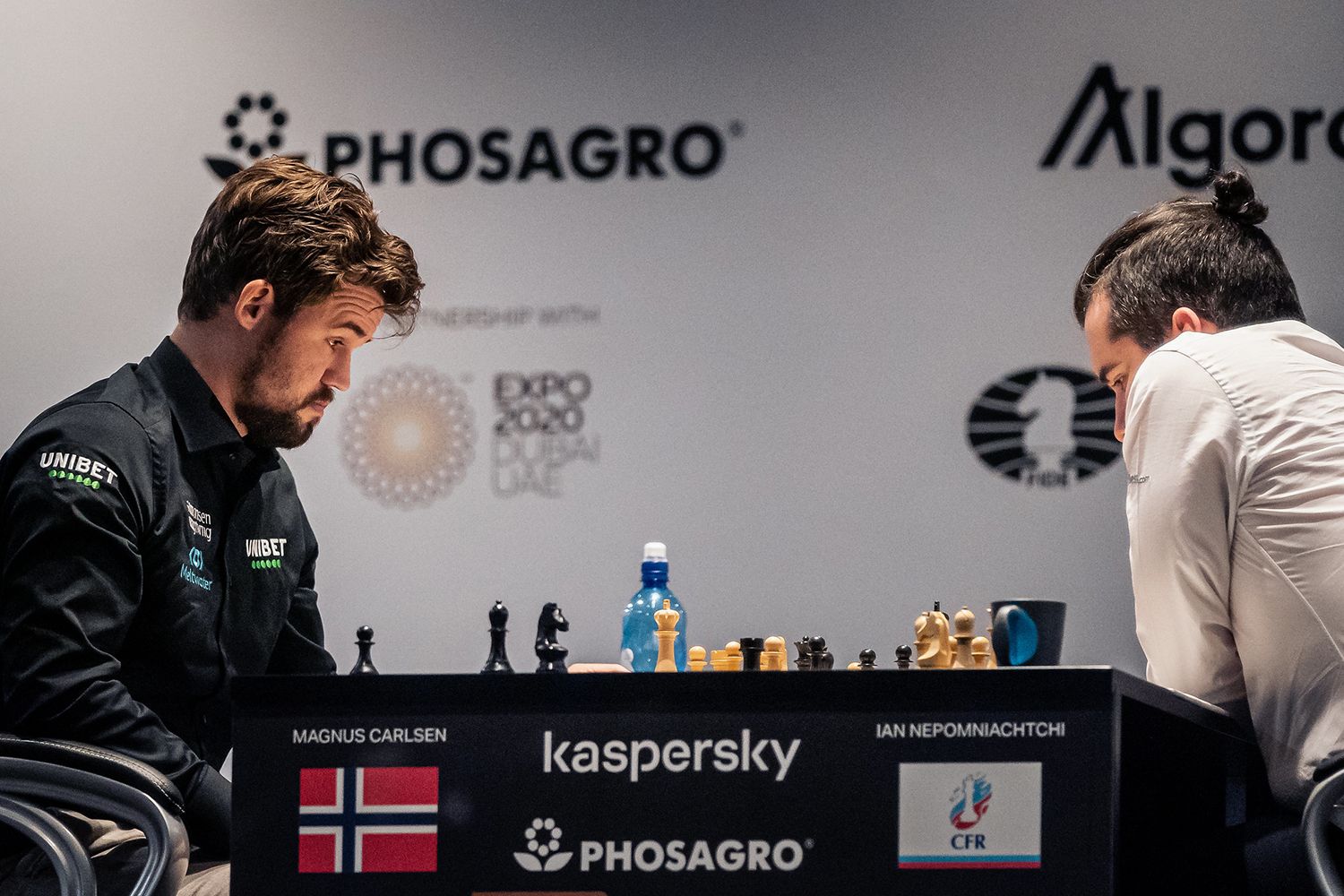
The next interesting moment in the game was 52…Qe4, played after just half a minute by Nepomniachtchi, seemingly trying to solve things tactically while neutral moves were possible.
Position after 52…Qe4.
It was a surprise that Nepomniachtchi allowed 53.Rxa3! here, where 53...Bxa3 54.Rxa3 was actually quite promising for White. The Russian GM had planned and played 53...Qxh4+ instead, but not before shaking his head a little. He might have missed Carlsen's 54.Kg1!, and if anyone had (small) chances here, it was Carlsen—especially after he found the nice 56.Ne2!.
However, once again the player with the advantage let go of it at some point.
Position after 58...Qd5+
Carlsen's very committal 59.f3 was seen by the experts as a surprising decision, with Caruana going as far as calling it "irresponsible" as from that moment on, the white king was always somewhat unsafe. At that point, everyone expected a draw again, and hardly anyone predicted another turn of events.
The world champion, now having used most of his time and playing on increment from move 75 onward, kept on pressing and managed to win one of Black's f-paws on move 79. As he took the pawn, he hesitated and then fumbled a bit, revealing the tension in the room.
A few moves later, he used a small tactic that gave a rook for pawn and a bishop, and the game entered its last act. Carlsen, with a rook, knight, and three pawns vs. a queen and one pawn for Nepomniachtchi, could still play for two results.
The moment Carlsen played 80.Rxf7+! Kxf7 81.Rb7+ Kg6 82.Rxa7.
As the game progressed, the statisticians had a field day. At move 81, it had been a thousand classical moves since the last decisive classical world championship game. A bit later, it became Carlsen's third world championship game that went beyond 100 moves—before it broke the record for longest game.
Eventually, White's g-pawn was traded for Black's h-pawn and we entered seven-man tablebase territory. It was a theoretical draw, but of course, Carlsen kept on trying.
I'm completely exhausted watching this game, I can't even imagine how Magnus and Nepo feel
— GothamChess (@GothamChess) December 3, 2021
It was on move 130 that Nepomniachtchi made the decisive mistake. With an iron hand, and now watched by 140K(!) viewers on the Chess.com Twitch channel, Carlsen converted the full point as he managed to push his pawns up the board while guarding his king against checks.
Whereas he began the round well dressed, Nepomniachtchi had his jacket on his chair—several buttons were undone on his shirt and his sleeves were rolled up. It had been an enormous fight.
Carlsen, who had left his jacket in his private resting area, shook his opponent's hand with his right hand while stopping the clock with his left hand, breathing a sigh of relief. Job done.
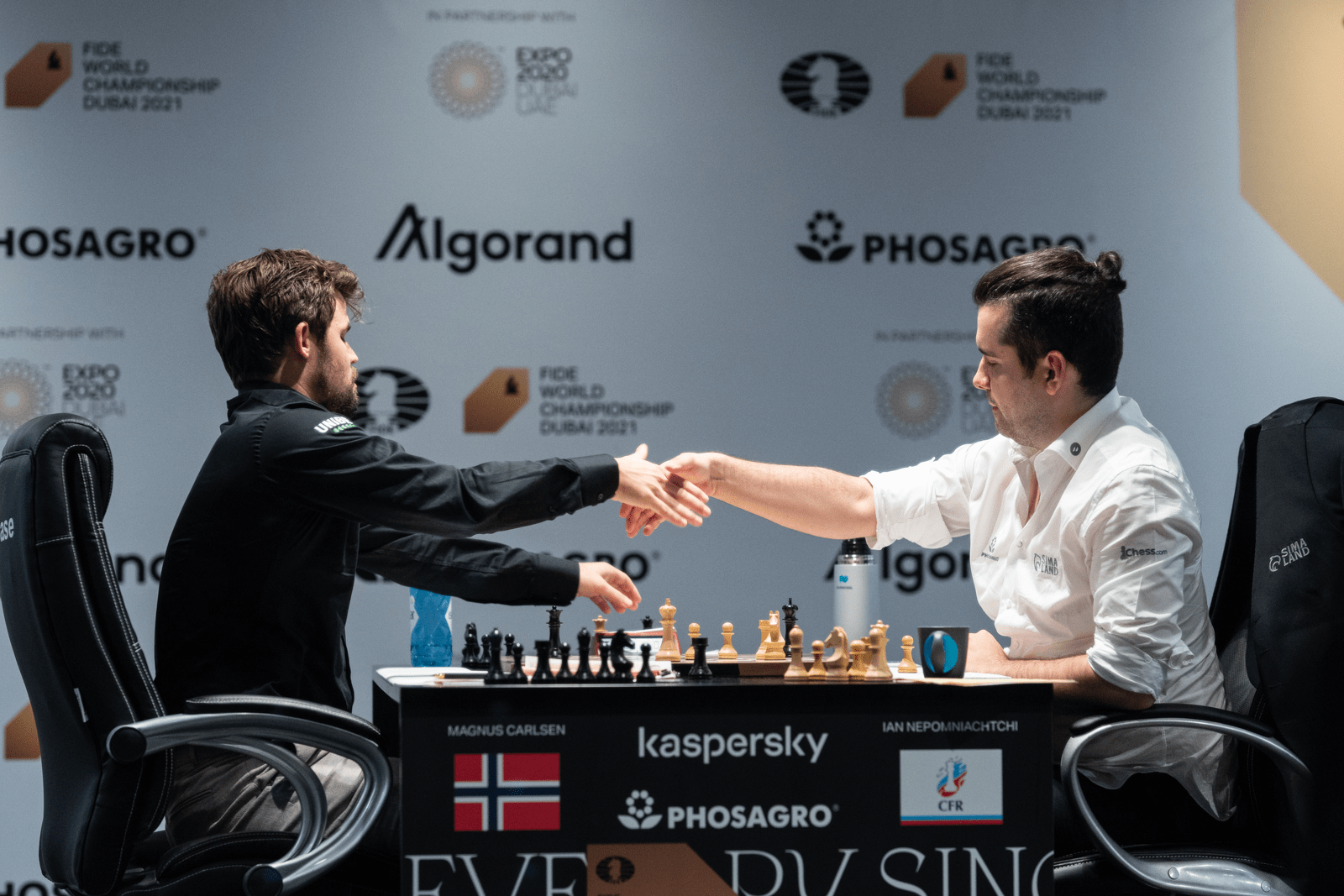
Match score
| Fed | Name | Rtg | 01 | 02 | 03 | 04 | 05 | 06 | 07 | 08 | 09 | 10 | 11 | 12 | 13 | 14 | Score |
| Magnus Carlsen | 2855 | ½ | .½ | ½ | ½ | ½ | 1 | . | . | . | . | . | . | . | . | 3½ | |
| Ian Nepomniachtchi | 2782 | ½ | ½ | ½ | ½ | ½ | 0 | . | . | . | . | . | . | . | . | 2½ |
"Obviously I'm elated to get this result," said Carlsen. "It was never easy nor, frankly, it shouldn't be, and there was a lot of the same emotions as the game that I won against [Sergey] Karjakin where it was just a marathon there as well so... obviously, that was huge!"

Known for always being quite fit, the Norwegian GM admitted this was a tiring affair: "Sure, but I think that's the way it is. As I said, it shouldn't be easy in a world championship match. You have to try for every chance no matter how small it is. Part of it was by design at some point that I thought I should make the game as long as possible so that we would both be as tired as possible when the critical moment came. That turned out to be a good strategy."
I thought I should make the game as long as possible so that we would both be as tired as possible when the critical moment came.
—Magnus Carlsen
Nepomniachtchi: "I would say that Magnus managed to capitalize on the very few chances he got in the game, so that's very nice of him, but in general I believe even this queen against knight and rook and two pawns should be a draw, but once you play it's basically blitz. If you don't know the correct setup as Black and if you maybe misplace your queen a little bit, it becomes tricky already."

Asked whether winning such a long game gives extra pleasure, Carlsen replied: "Yes!"
Nepomniachtchi, on how he plans to bounce back: "Hopefully, in style."
Chess.com’s coverage is brought to you by Coinbase. Whether you’re looking to make your first crypto purchase or you’re an experienced trader, Coinbase has you covered. Earn crypto by learning about crypto with Coinbase Earn, power up your trading with Coinbase’s advanced features, get exclusive rewards when you spend with Coinbase Card, and much more. Learn more at Coinbase.com/Chess.
Previous reports:
- Know The Champion: Magnus Carlsen
- Know The Challenger: Ian Nepomniachtchi
- All The World Chess Champions
- FIDE Chess World Championship 2021 All The Info: Carlsen-Nepomniachtchi
- FIDE World Championship Officially Opened After Press Conference Clash Of Frenemies - Chess.com
- FIDE World Championship G1: Nepo Impresses Under Pressure - Chess.com
- FIDE World Chess Championship Game 2: Adventurous Carlsen Scrambles For Draw
- FIDE World Chess Championship Game 3: Magnus Bulletproof With Black
- Nepo Holds Carlsen With Petroff In Game 4 FIDE World Chess Championship
- Carlsen Defends Passively To Draw Game 5 FIDE World Chess Championship

